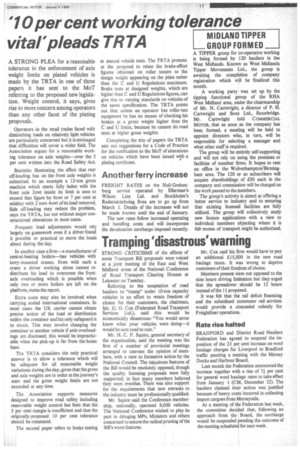'1 0 per cent working tolerance
Page 19

If you've noticed an error in this article please click here to report it so we can fix it.
vital' pleads TRTA Do Li. jApNFDO TRI rvrEEDR
A STRONG PLEA for a reasonable tolerance in the enforcement of axle weight limits on plated vehicles is made by the TRTA in one of three papers it has sent to the MoT referring to the proposed new legislation. Weight control, it says, gives rise to more concern among operators than any other facet of the plating proposals.
Operators in the retail trades faced with diminishing loads on relatively light vehicles are particularly concerned but it is envisaged that difficulties will cover a wider field. The Association argues for a reasonable working tolerance on axle weights—over the 5 per cent written into the Road Safety Act.
Statistics illustrating the effect that rear off-loading has on the front axle weights is submitted. In an example a 12-ton gross machine which starts fully laden with the front axle 2cwt inside its limit is seen to exceed that figure by 6cwt or 7 per cent at midday with 2 tons 4cwt of its load removed. Side off-loading may reduce the problem, says the TRTA, but not without major constructional alterations in most cases.
Frequent load adjustments would rely largely on guesswork even if a driver found it possible or practical to move the loads about during the day.
In another case a firm—a manufacturer of central-heating boilers—has vehicles with lorry mountedcranes. Even with such a crane a driver working alone cannot redistribute his load to overcome the frontaxle overloading which is possible when only two or more boilers are left on the platform, states the report.
Extra costs may also be involved when carrying sealed international containers. In most cases the UK carrier cannot obtain precise notice of the load or distribution within the container and his only safeguard is to check. This may involve changing the container to another vehicle if axle overloadings are disclosed; this would be impracticable when the pick-up is far from the home base.
The TRTA considers the only practical answer is to allow a tolerance which will be adequate for all reasonable weight variations during the day, given that the gross and axle weights are in order at the journey's start and the gross weight limits are not exceeded at any time.
The Association supports measures designed to improve road safety including reasonable weight control but feels that the 5 per cent margin is insufficient and that the originally-proposed 10 per cent tolerance should be reinstated.
The second paper refers to brake testing at annual vehicle tests. The TRTA protests at the proposal to relate the brake-effort figures obtained on roller testers to the design weight appearing on the plate rather than the C and U Regulations maximum. Brake tests at designed weights, which are higher than C and U Regulations figures, can give rise to varying standards on vehicles of the same specification. The TRTA points out that unless an operator has roller-test equipment he has no means of checking his brakes at a gross weight higher than the C and U limits, because he cannot do road tests at higher gross weights.
Completing the trio of papers the TRTA sets out suggestions for a Code of Practice for the notification to the MoT of alterations on vehicles which have been issued with a plating certificate.
Another ferry increase
FREIGHT RATES on the Hull-Gothenburg service operated by Ellerman's Wilson Line Ltd. and Stockholm's Rederiaktiebolag Svea are to go up from March 1. Details of the increases will not be made known until the end of January.
The new rates follow increased operating and handling costs and will incorporate the devaluation surcharge imposed recently.










































































































